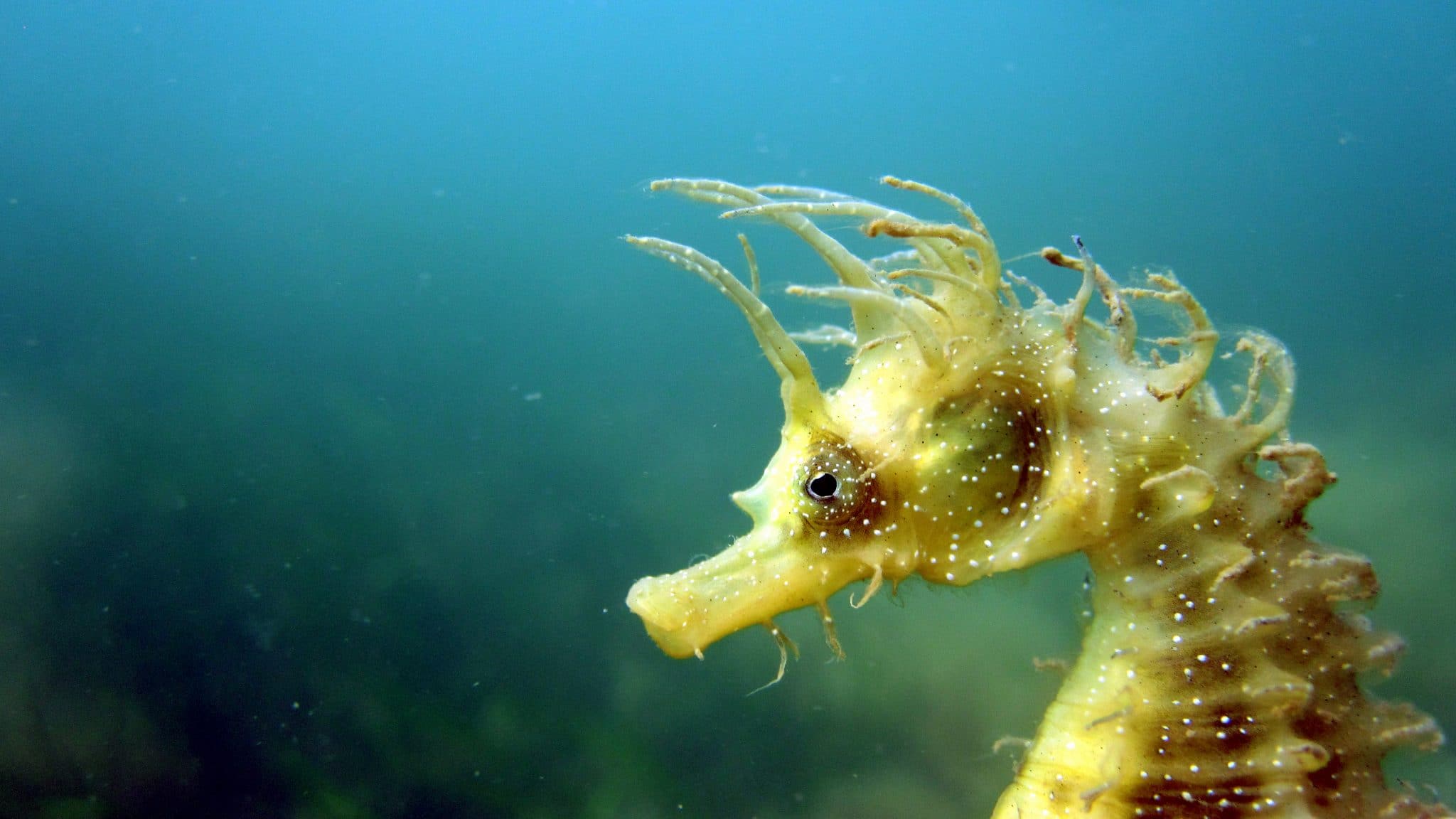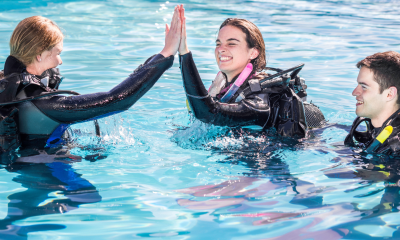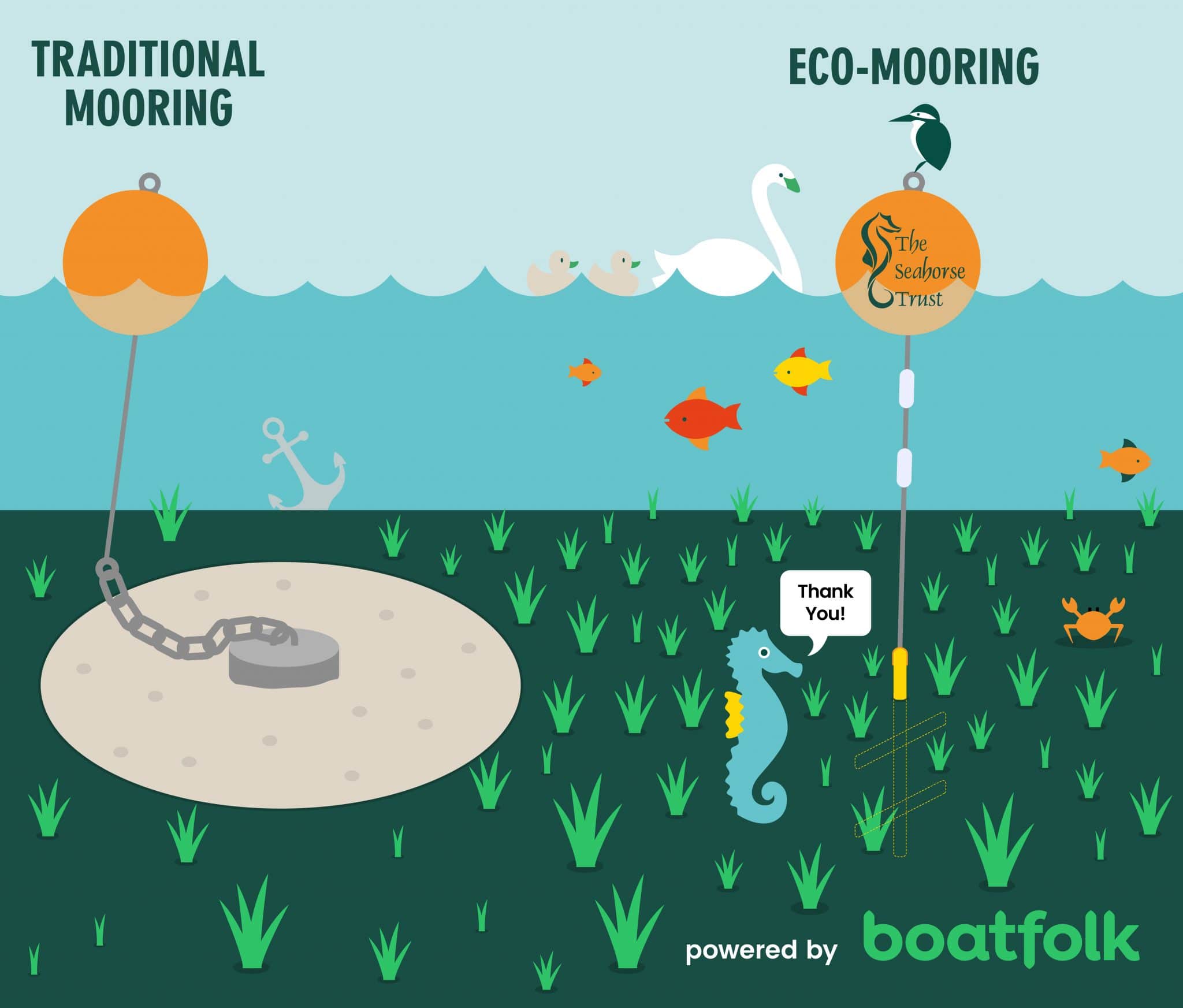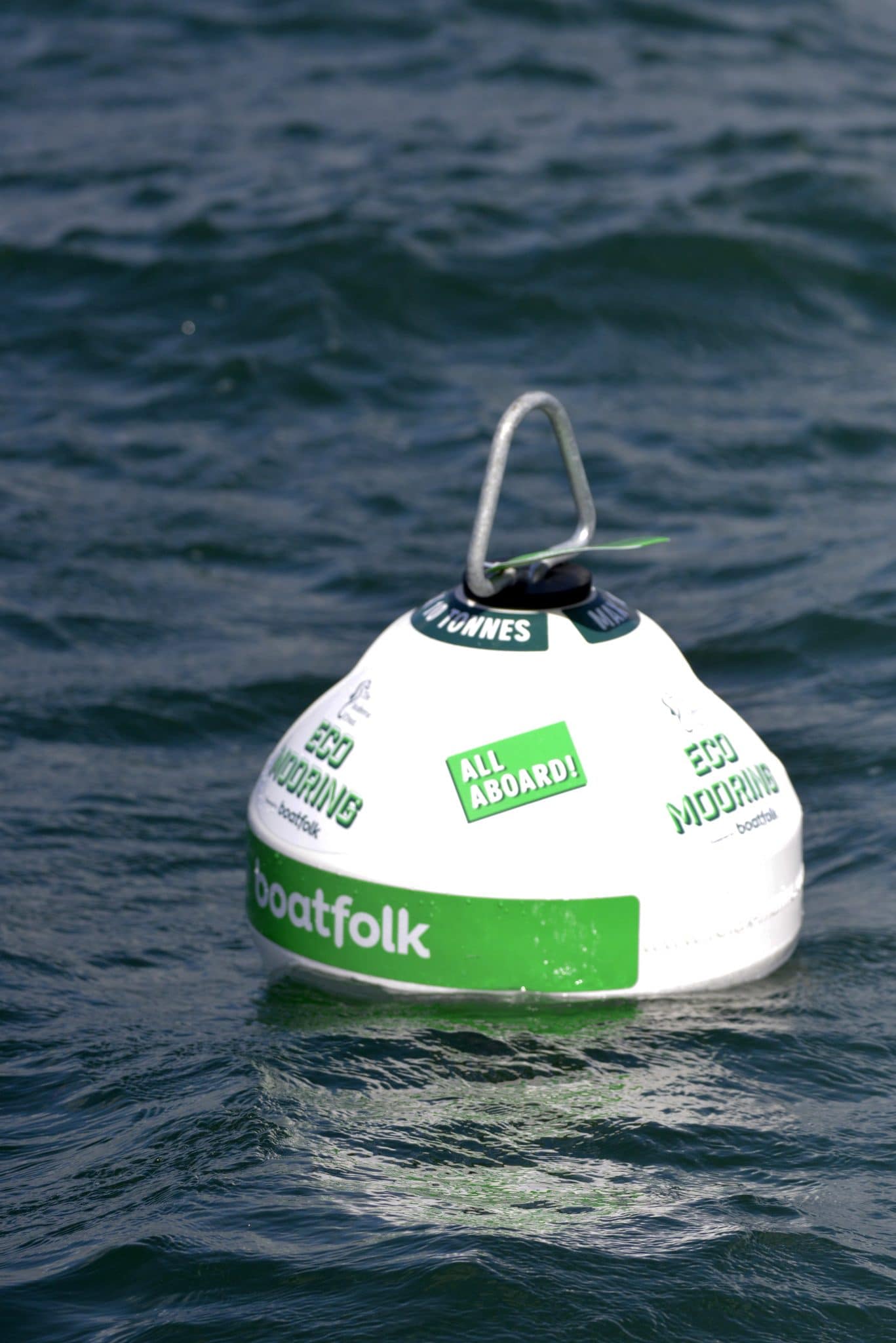Marine Life & Conservation
Boating and conservation worlds unite to save Studland’s seagrass and seahorses

Charity The Seahorse Trust and national marina group boatfolk have joined forces to deliver a practical solution for saving Studland’s unique marine environment.
The two organisations have collaborated on a not-for-profit scheme to put ten ‘eco-moorings’ into Studland Bay to give boaters an attractive, environmentally friendly alternative to dropping their anchors. The dropping of anchors has damaging consequences for seabed environments including seagrass meadows. This is a significant concern as seagrass provides essential habitat for species including seahorses and also stores up to twice as much carbon per hectare as terrestrial forests, playing a major role in keeping climate change in check.
The scheme was recently approved by the Marine Management Organisation (MMO) following its designation in 2019 as a Marine Conservation Zone (MCZ) and installation of the new eco-moorings is now underway. The organisations’ eco-mooring proposal was supported by letters from high-profile conservation advocates including Chris Packham and Steve Backshall. The scheme is also being supported by Mitch Tonks and Rockfish who will provide funding for the installation of one of the eco-moorings.
The MCZ designation was made on the basis of Studland Bay’s seagrass meadows, which are an internationally important breeding ground for the Spiny Seahorse, one of Britain’s native seahorse species. The Spiny Seahorse was protected in 2008 under the Wildlife and Countryside Act following campaigning by the Seahorse Trust. The legal aim of the MCZ designation was to return both seagrass and seahorses to ‘favourable condition’.
Neil Garrick-Maidment, Founder and Executive Director of The Seahorse Trust said: “The designation of Studland Bay as a Marine Conservation Zone was a long-awaited and hugely significant moment in safeguarding UK seahorse populations. It is now vital that the area is effectively protected and that everyone who uses the bay does so responsibly and sustainably. I am delighted to be working with boatfolk to develop a practical solution, which allows boaters to continue enjoying this remarkable site, in a way which also enables the conservation of rare seagrass meadows and crucial seahorse breeding grounds.”
Michael Prideaux, Managing Director of boatfolk said: “In late August, I met Neil on the beach at Studland Bay. We were united by our shared passion for the environment and by a desire to work with, and alongside, the boating community for a solution that everyone can get behind. boatfolk is all about making it easy for people to get out on the water and to enjoy their time afloat. Providing an alternative option at Studland that protects this incredible marine environment is about doing the right thing for boaters and for our planet. Financial return is not an objective here; we are committed to making Studland Bay a sustainable boating destination for generations to come and are proud to be putting our name and resources behind the scheme.”
The scheme forms part of boatfolk’s wider sustainability strategy, Coastline Deadline, a new platform designed to back projects which have a real, positive and measurable impact on the coastline.
Michael Prideaux adds, “We know our industry has an impact on the environment and that not enough is being done to raise awareness and change behaviours. Our goal isn’t to stop people boating. In fact, it’s the opposite. By making changes now we want to ensure that the coastline and oceans remain a place that can be enjoyed for generations to come.”
The benefits of eco-moorings are well-documented. Such moorings involve a helical screw anchor being driven into the seabed. An elastic rode is then attached, connecting the anchor system with the mooring buoy. The elastic rode will stretch at higher tides and contract at lower tides meaning that none of the equipment scours the seagrass around it. The moorings also provide a hassle-free option for boaters, saving them the trouble of having to drop their own anchors (which can often drag before taking a hold and leave the boat owner to clean the equipment afterwards).
Neil Garrick-Maidment and Michael Prideaux commented: “The Seahorse Trust and boatfolk are united in a clear belief that eco-moorings are the way forward for Studland, allowing boaters to continue enjoying the site while seagrass and seahorses thrive alongside. We were thrilled to secure MMO approval for our proposal, which we believe provides a practical and collaborative roadmap to finally giving Studland Bay the effective protection it deserves, and are delighted that installation of the eco-moorings is now underway following successful tests of the helical screw.”
The Seahorse Trust and boatfolk are very grateful to award-winning Devon and Dorset restaurant group Rockfish for their generous sponsorship of one of the initial ten eco-moorings.
Mitch Tonks, restaurateur, Rockfish and Seahorse restaurants, and co-founder of the Devon Environment Foundation, expressed his support for the scheme: “We believe Rockfish has a purpose beyond our restaurants. This is exactly the sort of project we like to support – practical, visible and useful, as well as changing the way we impact our world. It’s this on-the-ground stuff we love that people like The Seahorse Trust go out there and do.”
For more information on the work of The Seahorse Trust visit their website by clicking here.
Header image: Neil Garrick-Maidment
Blogs
Invitation from The Ocean Cleanup for San Francisco port call

6 years ago, The Ocean Cleanup set sail for the Great Pacific Garbage Patch with one goal: to develop the technology to be able to relegate the patch to the history books. On 6 September 2024, The Ocean Cleanup fleet returns to San Francisco bringing with it System 03 to announce the next phase of the cleanup of the Great Pacific Garbage Patch and to offer you a chance to view our cleanup system up-close and personal.
We look forward to seeing you there.
To confirm your presence, please RSVP to press@theoceancleanup.com
PROGRAM
Join The Ocean Cleanup as our two iconic ships and the extraction System 03 return to San Francisco, 6 years and over 100 extractions after we set sail, to create and validate the technology needed to rid the oceans of plastic.
Our founder and CEO, Boyan Slat, will announce the next steps for the cleanup of the Great Pacific Garbage Patch. Giving you a chance to view our cleanup system and the plastic extracted.
Hear important news on what’s next in the mission of The Ocean Cleanup as it seeks to make its mission of ridding the world’s oceans of plastic an achievable and realistic goal.
Interviews and vessel tours are available on request.
PRACTICALITIES
Date: September 6, 2024
Press conference: 12 pm (noon)
Location: The Exploratorium (Google Maps)
Pier 15 (Embarcadero at Green Street), San Francisco, CA
Parking: Visit The Exploratorium’s website for details.
RSVP: press@theoceancleanup.com
Video & photo material from several viewing spots around the bay
We look forward to seeing you there!
ABOUT THE OCEAN CLEANUP
The Ocean Cleanup is an international non-profit that develops and scales technologies to rid the world’s oceans of plastic. They aim to achieve this goal through a dual strategy: intercepting in rivers to stop the flow and cleaning up what has already accumulated in the ocean. For the latter, The Ocean Cleanup develops and deploys large-scale systems to efficiently concentrate the plastic for periodic removal. This plastic is tracked and traced to certify claims of origin when recycling it into new products. To curb the tide via rivers, The Ocean Cleanup has developed Interceptor™ Solutions to halt and extract riverine plastic before it reaches the ocean. As of June 2024, the non-profit has collected over 12 million kilograms (26.4 million pounds) of plastic from aquatic ecosystems around the world. Founded in 2013 by Boyan Slat, The Ocean Cleanup now employs a broadly multi-disciplined team of approximately 140. The foundation is headquartered in Rotterdam, the Netherlands, and opened its first regional office in Kuala Lumpur, Malaysia, in 2023.
Find out more about The Ocean Cleanup at www.theoceancleanup.com.
Marine Life & Conservation
SHARK MONTH ARRIVES AT ROYAL WILLIAM YARD, PLYMOUTH

A shark has been spotted approaching Royal William Yard in Plymouth, much to the surprise of swimmers, paddleboarders and onlookers.
With its distinctive dorsal fin cutting through the water, the sizeable shark swam along the coastline, before turning to head inland towards Firestone Arch at Royal William Yard. The appearance drew a crowd, who were captivated for more than an hour by the unusual sight – and it was all caught on video.
The shark is one of many expected sightings at Royal William Yard over the coming weeks… because today marks the start of Shark Month!
In reality, the ‘shark’ spotted along the Plymouth shoreline was actually a custom-made model, created by the team at Royal William Yard and sailed underwater by Caroline Robertson‑Brown from the Shark Trust, who donned scuba diving gear for the occasion.
The stunt took place to launch Shark Month in style and draw attention to the work of the leading international conservation charity, which is based in Britain’s Ocean City. Spectators were reassured that the water was safe and many entered into the spirit of the performance, swimming or sailing alongside the shark.
Shark Month will take place across Royal William Yard throughout July and will feature an extravaganza of art, entertainment and advocacy for everyone to enjoy. The packed programme of events starts with an art exhibition and ends with a trip on paddleboards with shark experts – with everything from a shark quiz to a Jaws screening in between.
Paul Cox, CEO of the Shark Trust, said: “There are often assumptions and misconceptions when it comes to sharks. This was certainly the case with the shark spotted at Royal William Yard! While the British coastline is home to many species of shark, this was not one of them. However, we’re thrilled it caught people’s attention, because seeing a shark is a special and memorable moment. That is precisely why we want to celebrate these incredible creatures, highlight the need for conservation, and ask for help to safeguard their future.”
For more information about Shark Month at Royal William Yard, visit the Shark Trust Website.
Images and video: Jay Stone
-

 Blogs2 months ago
Blogs2 months agoDiving With… Nico, Ocean Earth Travels, Indonesia
-

 News1 month ago
News1 month agoMurex Bangka Announce New Oceanfront Cottages & Beachfront Dining
-

 Blogs2 months ago
Blogs2 months agoA new idea in freediving from RAID
-

 Marine Life & Conservation1 month ago
Marine Life & Conservation1 month agoIceland issue millionaire whale hunter a licence to murder 128 vulnerable fin whales
-

 Marine Life & Conservation2 months ago
Marine Life & Conservation2 months agoThe Shark Trust Great Shark Snapshot is back
-

 News3 months ago
News3 months agoCharting New Waters; NovoScuba Goes Global with the Launch of their Revolutionary Dive Training Agency!
-

 Gear News1 month ago
Gear News1 month agoNew Suunto Ocean – a dive computer and GPS sports watch in one for adventures below and above the surface
-

 Marine Life & Conservation Blogs2 months ago
Marine Life & Conservation Blogs2 months agoBook Review: Plankton

















